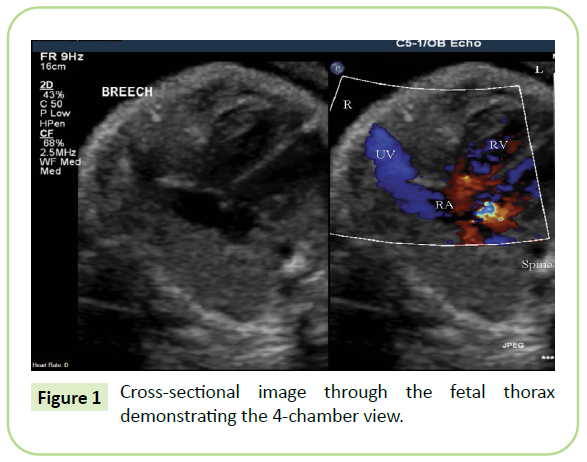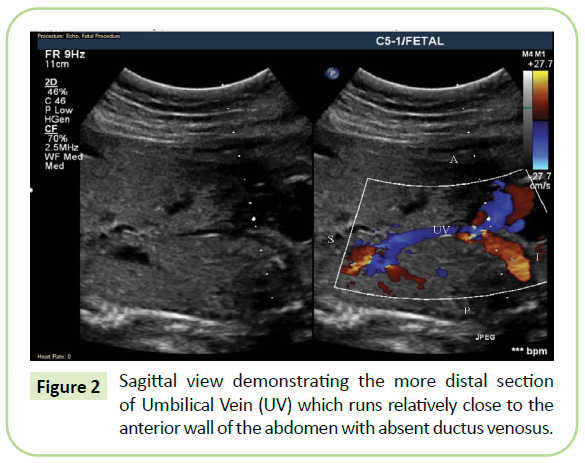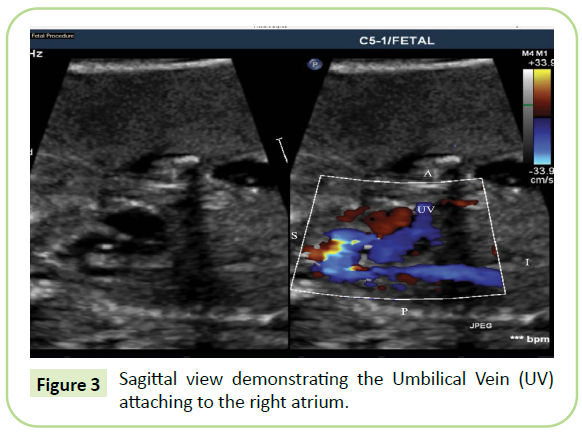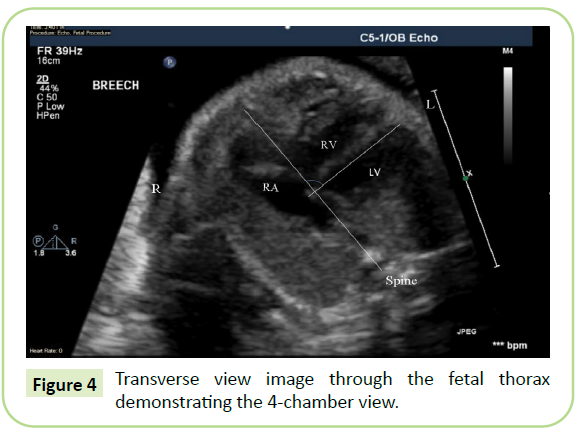Osei FA1* and Brewer J2
1Children’s of Mississippi, University of Mississippi Medical Center, MS-39216, USA
2North Mississippi Medical Center, MS-39216, USA
- *Corresponding Author:
- Frank A. Osei
Children’s of Mississippi
University of Mississippi Medical Center
1150 South Green Street, Building #2,
Suite D Tupelo, MS-39216, USA.
Tel: +1-8435303398
E-mail: fosei@umc.edu
Received Date: May 28, 2021; Accepted Date: June 21, 2021; Published Date: June 28, 2021
Citation: Osei FA, Brewer J (2021) Umbilical Vein Connection to Right Atrium with Absent Ductus Venosus: A Rare Congenital Defect. Gynecol Obstet Case Rep Vol.7 No.6:143.
Introduction: An abnormal course of the Umbilical Vein (UV) is a rare anomaly and this can be associated with the congenital absence of the Ductus Venosus (DV), cardiac and extra-cardiac anomalies. The major clinical importance of these anomalies is the need to recognize them during prenatal and postnatal diagnostic studies and at the time of cannulation or catheterization of the umbilical vein in sick neonates. Through targeted examination of the fetal heart and the venous system, a correct prenatal diagnosis is possible.
Case Report: A 25-year-old gravida 1 para 0 with type 1 diabetes mellitus at 21+6 weeks gestation referred for fetal echocardiogram because abnormal vessel was noted connecting the UV to the right atrium on the obstetric ultrasound by her maternal fetal medicine specialist. A diagnosis of drainage of the UV directly into the right atrium with absent DV and other minor cardia defects were made on the fetal echocardiogram. Preterm delivery occurred at 31+3 weeks gestation and had a favorable clinical course.
Conclusion: An abnormal course of the umbilical vein is a rare anomaly and this can be associated with the congenital absence of the Ductus Venosus (DV), cardiac and extra-cardiac anomalies. Through a thorough and meticulous ultrasonographic assessment, the diagnosis can be made and that will be helpful in guiding the management of the rest of the pregnancy and counsel the family what to expect.
Keywords
Umbilical vein; Ductus venosus; Right atrium
Introduction
An abnormal course of the Umbilical Vein (UV) is a rare anomaly
and this can be associated with the congenital absence of the
Ductus Venosus (DV) [1]. DV connects the portal and embryonic
venous circulation into the inferior vena cava [2]. Through
targeted examination of the fetal heart and the venous system,
a correct prenatal diagnosis of rare anomalies, like abnormal
course of the umbilical vein and absent ductus venosus, is
possible. Usually the primary finding is an abnormal course of
the UV, and the secondary finding is often an absent DV. Close
follow-up of fetuses with abnormal venous systems but no other
associated malformations can help to diagnose early signs of fetal
decompensation and also help to determine the optimal time for
delivery [1]. Early diagnosis and the associated abnormalities may
also help the family to have an idea of what to expect postnatally.
We present a case that was diagnosed at 21+6 weeks gestation
and had a relatively favorable outcome.
Case Report
A 25-year old gravida 1 para 0 with type 1 diabetes mellitus at
21+6 weeks gestation referred for fetal echocardiogram because
a vessel was noted connecting the UV to the right atrium on the
obstetric ultrasound by her maternal fetal medicine specialist.
The fetal echocardiogram confirmed the drainage of the UV
directly into the right atrium with absent DV (Figures 1-3)
and the other main cardiac findings included cardiomegaly,
levorotation of the cardiac axis (Figure 4), and a very small
muscular ventricular septal defect. There was periodic follow
up during the rest of the pregnancy. She had issues associated
with her diabetes mellitus and because she wanted to move closer to her endocrinologist, she relocated her obstetric care to
our main campus in a different city. She went into prenatal labor
and delivered at 31+3 weeks gestation. The main findings on the
postnatal echocardiogram were a small muscular ventricular septal defect and patent foramen ovale. Physical examination
was unremarkable and the hospital stay was uneventful except
for the repair of bilateral inguinal hernia repair, left orchiopexy,
and right hydrocele drainage at 47 days old. The baby was seen in
pediatric cardiology clinic at 2 months of age, he was otherwise
reportedly asymptomatic from the cardiac standpoint, and his
follow up echocardiogram continued to show the small muscular
ventricular septal defect and patent foramen ovale.
Figure 1: Cross-sectional image through the fetal thorax demonstrating the 4-chamber view.
Figure 2: Sagittal view demonstrating the more distal section
of Umbilical Vein (UV) which runs relatively close to the
anterior wall of the abdomen with absent ductus venosus.
Figure 3: Sagittal view demonstrating the Umbilical Vein (UV)
attaching to the right atrium.
Figure 4: Transverse view image through the fetal thorax
demonstrating the 4-chamber view.
Discussion
Embryologically the paired umbilical veins appear between 2 and
4 weeks of gestational age and after passing through the septum
transversum, drain into the sinus venosus. As the liver primordium
grows into the septum transversum, the umbilical veins lose their
connection to the sinus venosus and develop connections to the
hepatic sinusoids. Normally, the right UV regresses by 4½ weeks
and only the left UV persists, which enters the hepatic sinusoids
or the portal system [3]. Later, the normal in utero drainage of
the UV into the portal venous system and then through the DV
into the right atrium occurs. However, if the normal connection
between the umbilical veins and the sinusoids is not formed, the
right UV may persist. The persistent right UV may retain a number
of primitive channels, including direct connection of the UV with
the right atrium. Other aberrant connections include UV drainage
into the suprahepatic or Inferior Vena Cava (IVC), infrahepatic IVC,
iliac veins, or subcutaneous collateral vessels into the superior
vena cava [4].
The explanation of the direct inflow into the right atrium is that the
right UV, which normally totally disappears during the 7th week,
persists. If the right UV is not really affected by the development
of the liver and the septum transversum, it does not terminate
in the developing liver but runs relatively close to the front wall
of the abdomen in the falciform ligament, and enters the right
atrium directly on the diaphragmatic surface of the liver [1].
If the anastomosis between the hepatic sinusoids and the
umbilical veins is lost, a number of different aberrant drainages
of the umbilical vein or umbilico-systemic connections may
occur and may be associated with different malformations. The anomalies of the umbilical vein within the fetal abdomen that
may be detected with prenatal sonography may be divided
into three groups: a direct inflow into the right atrium, a direct
connection with the infrahepatic part of the IVC (these two
bypass the portal system) and a direct connection with the vena
porta system (in this latter case the whole blood mass coming
through the umbilical vein has to pass the portal system) [5,6].
The ductus venosus, which develops in the 5th to 6th gestational
week on the visceral surface of the liver, connects the persistent
caudal part of the left umbilical vein with the IVC, and due to this
anastomosis, normally about 30% of the blood arriving from the
placenta can bypass the hepatic sinusoids and enter the heart
directly. The well-oxygenated blood from the ductus venosus
preferentially passes through the foramen ovale into the left
atrium to supply the arteries leading to the brain directly. The
rest of the blood from the UV passes through the left portal vein
into the left lobe of the liver [7,8]. The constricting sphincter
mechanism around the origin of the DV from the UV is believed
to protect the fetal brain from excessive placental flow. Excessive
placental blood returning to the fetal heart occurs when the DV is
bypassed, as with a persistent right UV entering the inferior vena
cava or right atrium [9]. This explains why there was cardiomegaly
in our case (CTR=0.6).
In the absence of DV, the normal streaming of highly oxygenated
umbilical venous blood through the foramen ovale to the left
atrium is absent. However, entire oxygenated blood from the
placenta returns directly into the heart via the UV, so that fetal
arterial blood oxygen concentration may not be affected [10].
It has been shown that the cardiothoracic ratio of the fetus
correlate with the central venous pressure. The presence of
cardiomegaly indicates that direct drainage of the umbilical vein into the heart leads to high central venous pressure [11,12]. This
raised central venous pressure is most likely due to the volume
overload as a result of loss of the DV regulatory mechanism [13].
This chronic volume overload may lead to increased demands on
the fetal myocardium with the risk of high-output heart failure,
leading to fetal hydrops [10]. Fetuses with DV agenesis appear to
be at risk of additional cardiac and extra-cardiac anomalies [12].
Anomalies that commonly occur involve the gastrointestinal,
cardiovascular, genitourinary and musculoskeletal systems
[3]. Cardiovascular anomalies may include atrial septal defect,
ventricular septal defect or more complex cardiac malformations.
The most commonly associated genitourinary tract anomalies
include bilateral hydronephrosis, ectopic kidney and unilateral
renal agenesis. Musculoskeletal anomalies such as hemivertebrae
have also been reported. A single umbilical artery or two-vessel
cord has also been noted in some cases. Fortunately our patient
did not have any significant congenital anomalies apart from the
small muscular ventricular septal defect which was noted during
the prenatal period and the inguinal hernia and the hydrocele
noted postnatally.
Conclusion
An abnormal course of the umbilical vein is a rare anomaly and
this can be associated with the congenital absence of the Ductus
Venosus (DV), cardiac and extra-cardiac anomalies. Through
a thorough and meticulous ultrasonographic assessment, the
diagnosis can be made and that will be helpful in guiding the
management of the rest of the pregnancy and counsel the family
what to expect. In the absence of any other major abnormality,
the prognosis of babies with direct umbilical venous return into
the heart can be good.
References
- Hajdu J, Marton T, Kozsurek M, Pete B, Csapo Z, et al. (2008) Prenatal diagnosis of abnormal course of umbilical vein and absent ductus venosus: Report of three cases. Fetal Diagn Ther 23: 136-139.
- Balique JG, Regairaz C, Lemeur P, Espalieu P, Hugonnier G, et al. (1984) Anatomical and experimental study of the ductus venosus. Anat Clin 6: 311-316.
- Jeanty P (1990) Persistent right umbilical vein: An ominous prenatal finding? Radiology 177: 735-738.
- Greiss HB, McGahan JP (1992) Umbilical vein entering the right atrium: Significance of in utero diagnosis. J Ultrasound Med 11: 111-113.
- Moore L, Toi A, Chitayat D (1996) Abnormalities of the intra-abdominal fetal umbilical vein: Reports of four cases and a review of the literature. Ultrasound Obstet Gynecol 7: 21-25.
- Hofstaetter C, Plath H, Hansmann M (2000) Prenatal diagnosis of abnormalities of the fetal venous system. Ultrasound Obstet Gynecol 15: 231-241.
- Kiserud T (2001) The ductus venosus. Semin Perinatol 25: 11-20.
- Huisman TW, Stewart PA, Wladimiroff JW (1992) Ductus venosus blood flow velocity waveforms in the human fetus: A Doppler study. Ultrasound Med Biol 18: 33-37.
- Gennser G (1992) Fetal ductus venosus and its sphincter mechanism. Lancet 339: 132-134.
- Jaeggi ET, Fouron JC, Hornberger LK, Proulx F, Oberhänsli I, et al. (2002) Agenesis of the ductus venosus that is associated with extrahepatic umbilical vein drainage: prenatal features and clinical outcome. Am J Obstet Gynecol 187: 1031-1037.
- Johnson P, Sharland G, Allan DL, Tynan MJ, Maxwell DJ (1992) Umbilical venous pressure in non-immune hydrops fetalis: Correlation with cardiac size. Am J Obstet Gynecol 167: 1309-1313.
- Sau A, Sharland G, Simpson J (2004) Agenesis of the ductus venosus associated with direct umbilical venous return into the heart: Case series and review of literature. Prenat Diagn 24: 418-423.
- Mavrides E, Moscoso G, Carvalho JS, Campbell S, Thilaganathan B (2002) The human ductus venosus between 13 and 17 weeks of gestation: Histological and morphometric studies. Ultrasound Obstet Gynecol 19: 39-46.





